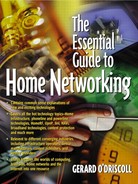IEEE 1394
The IEEE 1394 standard, also known as the FireWire Bus, is a new interface alternative for high-speed data transfer between digital set-top boxes and personal computers. The FireWire Bus standard, originally created by Apple Computer, was born out of the need for a low-cost, consumer-oriented connection between digital-video recorders and personal computers. It grew into a standard called the IEEE 1394 for low-cost, high-data-rate connections.
In 1994, an organization called the 1394 Trade Organization was formed to support and promote the adoption of the 1394 standard. Today, the 1394 Trade Organization is comprised of over 170 member companies from all over the world.
Many of the major consumer electronics companies are currently working to incorporate IEEE 1394-ready ports into the next generation of digital set-top boxes. In order to understand how an IEEE 1394 port operates, we need to examine the standard itself in more detail. IEEE 1394 is a very complex serial bus protocol that is capable of bidirectional data rates at 400 Mbps. There is, however, a roadmap in place to eventually bring the speed of an IEEE 1394 port up to 1.6 gigabits per second (Gbps). Table 7.1 gives you an idea of how the IEEE 1394 data transfer rate compares with other connections used in a standard PC.
| Interface Description | Data Rate |
|---|---|
| RS-232 | 115 Kbps |
| Parallel port | 920 Kbps |
| IDE interface bus | 133.6 Mbps |
| Fast SCSI | 160 Mbps |
| USB | 12 Mbps |
| IEEE 1394 | 400 Mbps |
The cabling required to interconnect devices on an IEEE 1394-based home network is quite similar to that of Ethernet. So, unlike other home networking technologies, IEEE 1394 requires the installation of new wires. The IEEE 1394 cable medium allows up to 16 physical connections (cable hops), each up to 4.5 meters in length. This gives a home network using IEEE 1394 a total cable distance of 72 meters. Similar to Ethernet and other high-speed networking systems, IEEE 1394 adopts a layered approach to transmitting data across a physical medium. The physical layer provides the signals required by the IEEE 1394 bus within the set-top box. The link layer takes the raw data from the physical layer and formats it into recognizable 1394 packets. The transaction layer takes the packets from the link layer and presents them to the home networking-based application. Like all IEEE standards, IEEE 1394 is an open, royalty-free standard.
IEEE 1394 and Other Standards
IEEE 1394 multiplexes a variety of different types of digital signals, including video, audio, and device control commands, on two twisted-pair conductors. Multiplexing is used in virtually all analog and digital networking systems, but usually only a single type is involved. Ethernet, for example, multiplexes digital data over one (10Base2, "Thin" Ethernet) or two (10BaseT, 100BaseT) pairs of conductors. Transmitting real-time, high-quality audio and video data over Ethernet, however, requires special protocols presently implemented only in proprietary multimedia networking systems. IEEE 1394 is much more flexible in its accommodation of different data types and topologies, using a "fairness" arbitration approach to ensure that all nodes having information to transmit get a chance to use the bus. Standard Ethernet does not provide this important feature. As mentioned, USB is a very popular new connector and bus for computers. However, every USB message must be processed by a personal computer host. This "bottleneck," as well as the dependence on a PC being present in the USB system, makes USB an unlikely alternative to IEEE 1394. A 1394 bus does not require that a PC be present; it is optional. Bandwidth is another issue: IEEE 1394 operates at a much higher speed, with guaranteed delivery of audio and video samples. USB does not have the bandwidth necessary to transmit multiple video streams. For a more detailed description of the IEEE 1394 standard, we suggest that you download the complete specification from any of the Internet draft repository sites: http://www.1394ta.org. Companies like Sony have already begun to lay the groundwork for using the IEEE 1394 home networking standard for interconnecting a range of hardware products within the household.
